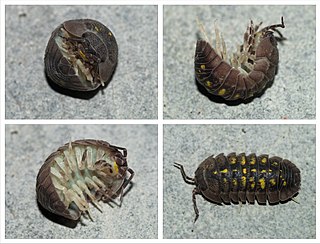
Armadillidium is a genus of the small terrestrial crustacean known as the woodlouse. Armadillidium are also commonly known as pill woodlice, leg pebbles, pill bugs, roly-poly, or potato bugs, and are often confused with pill millipedes such as Glomeris marginata. They are characterised by their ability to roll into a ball ("volvation") when disturbed.

Armadillidiidae is a family of woodlice, a terrestrial crustacean group in the order Isopoda. Unlike members of some other woodlice families, members of this family can roll into a ball, an ability they share with the outwardly similar but unrelated pill millipedes and other animals. This ability gives woodlice in this family their common names of pill bugs or roly polies. Other common names include slaters, potato bugs, butchy boys, and doodle bugs. Most species are native to the Mediterranean Basin, while a few species have wider European distributions. The best-known species, Armadillidium vulgare, was introduced to New England in the early 19th century and has become widespread throughout North America.
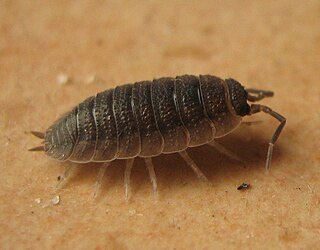
Porcellionidae is a terrestrial family of the order Isopoda.

Haplophthalmus is a genus of woodlice in family Trichoniscidae. It contains 47 described species, of which two are listed as vulnerable species on the IUCN Red List – Haplophthalmus abbreviatus and Haplophthalmus rhinoceros.

Styloniscus is a genus of woodlice in the family Styloniscidae. It contains the following species as of 2010:

Porcellio is a genus of woodlice in the family Porcellionidae. These crustaceans are found essentially worldwide. A well-known species is the common rough woodlouse, Porcellio scaber.
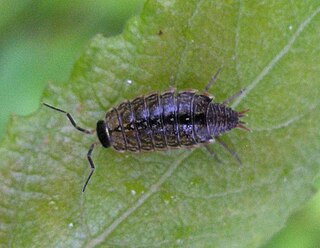
Philosciidae is a family of woodlice. They occur almost everywhere on earth, with most species found in (sub)tropical America, Africa and Oceania, and only a few in the Holarctic realm.
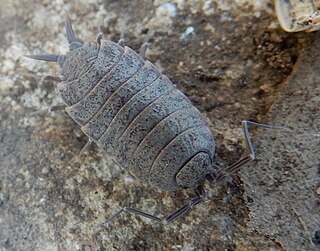
Porcellionides is a genus of woodlice in the family Porcellionidae. It includes the following species :

Hemilepistus is a genus of woodlice, first described by G. H. A. Budde-Lund in 1879 as a subgenus of Porcellio, but raised to the rank of genus by Karl Wilhelm Verhoeff in 1930. It contains the following species:

Agnaridae is a family of woodlice. They were formerly considered part of the Trachelipodidae, but were moved from that family to Porcellionidae in 1989, and then placed as a separate family in 2003.

Platyarthridae is a family of woodlice, containing the following genera:
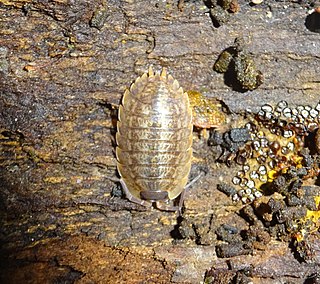
Porcellio montanus is a species of woodlouse in the genus Porcellio belonging to the family Porcellionidae that can be found in Czech Republic, France, Italy and Switzerland. Only one subspecies have been recorded, Porcellio montanus alpivagusVerhoeff, 1928.

Trachelipus is a genus of woodlice in the family Trachelipodidae, containing the following species:

Armadillidae is a family of woodlice, comprising around 80 genera and 700 species. It is the largest family of Oniscidea, and one of the most species-rich families of the entire Isopoda. Most of the armadillidae taxa are not monophyletic. Armadillids generally have a strongly convex body shape, with some rather shallowly convex. Like members of the woodlice family Armadillidiidae, armadillids are capable of enrolling into a sphere (conglobation), and are commonly known as pill bugs. Some species, however, have secondarily lost their conglobation ability. For example, a species exist in which the males lack the inner face of the coxal plates and are therefore unable to conglobate. Armadillids differ from the Armadillidiidae in that the antennae are fully enclosed within the sphere.
Scleropactidae is a family of woodlice, with a predominantly Gondwanan distribution. It contains the following genera:
Niambia is a genus of woodlice in the family Platyarthridae. There are at least 20 described species in Niambia.
Alpioniscus is a southern European genus of woodlice in the family Trichoniscidae. Alpioniscus consists of two subgenera: Alpioniscus s.s. and Illyrionethes. A 2019 study used molecular and taxonomic analyses to verify the validity of the current taxonomy, resulting in the redescription of several species and the description of two new species.

Eubelidae is a family of woodlice. Its members are mostly distributed in African tropical forests, and partially throughout South-East Asia and the Arabian Peninsula.

Armadillo is a genus of isopods belonging to the family Armadillidae.

Ctenorillo is a genus of woodlouse in the family Armadillidae.















